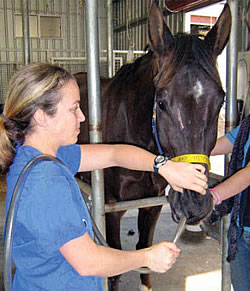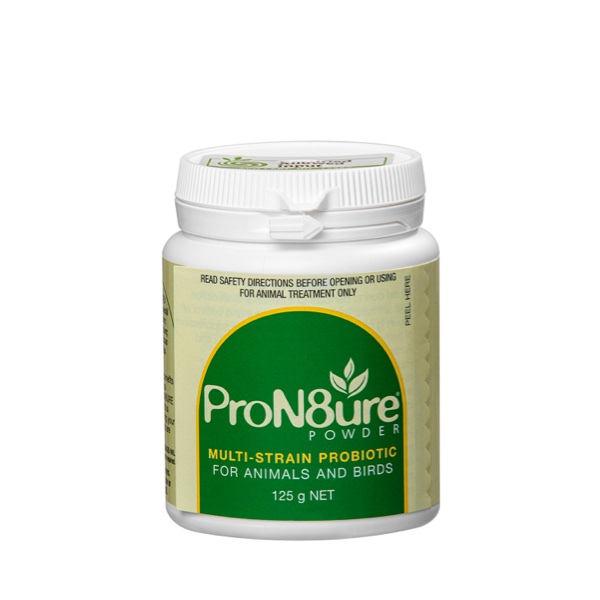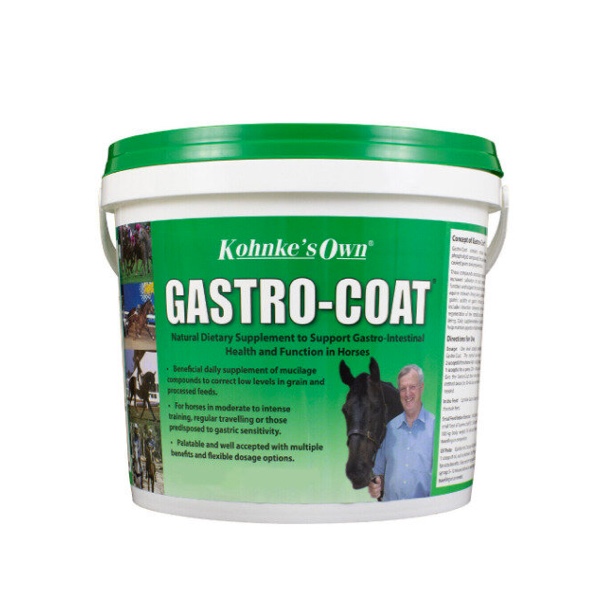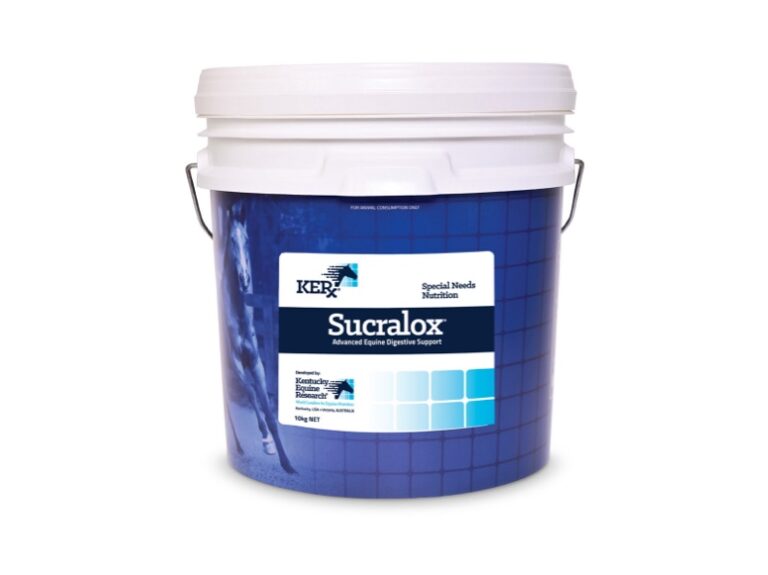Colic is arguably the most feared disease of horses. It seems that every horse owner knows of a horse that has died from colic. Colic is potentially fatal for horses, however the far majority of cases of colic respond to simple treatment and very few colics are fatal. The term ‘colic’ in horses simply describes abdominal or belly pain and it is likely that most horses will have an episode of colic at some time in their life. Providing that veterinary advice is sought early and that the appropriate treatments are given, a good outcome is usually achieved.
Symptoms of Colic
As horse owners it is extremely important that you can recognize the symptoms of colic in order to enable early veterinary intervention. In the mildest cases a horse may only show signs of depression and lack of appetite. With more painful colics the horse might turn and look at its belly repeatedly, they might sweat a little and curl their upper lip, and they may lie down more frequently than you would expect. Some horses with colic stretch out as if trying to urinate, and some dog sit with their hindquarter on the ground and forelimbs extended. As the pain worsens they may paw the ground with a front leg as if they are trying to dig a hole and if the pain gets worse your horse might roll about on its back on the ground, sometimes violently taking skin off from the sides of their head. These horses may distend in the belly, looking bigger and rounder than usual and they may or may not pass manure. However, be aware that a horse with severe and serious colic can still pass manure as the problem in the gut may be well forward of the rectum; the transit time from mouth to manure can be days.
If your horse shows symptoms of colic you should call your veterinarian immediately. Most colics will require urgent veterinary intervention to prevent the condition worsening. While waiting for veterinary assistance, prevent the horse’s access to hard feed and hay. If the horse is pawing the ground and wanting to roll about on his back then try walking them briskly to prevent them from going down until your veterinarian administers pain relief. Lunging can also help in some cases. There is risk that rolling around on the ground may result in a twisted bowel. BE CAREFUL with a violently rolling and thrashing horse. Do not put yourself at risk. If the horse cannot safely be kept on its feet, leave it down until the veterinarian arrives. Very painful horses can injure owners. These horses can suddenly throw themselves to the ground and you can get caught underneath them. You should also never administer pain-relieving medications without discussing this with your veterinarian, as these medications can mask the severity of the colic making it difficult for the veterinarian to assess your horse accurately.
Some horses dog-sit with their hindquarter on the ground and forelimbs extended
Causes Of Colic
The causes of colic are varied. Most colics are the result of gas build up in the gut, with distension and stretch of the gut wall causing pain. Others are due to increased motility resulting in excessive spasm of the gut. Conversely, some are the result of complete loss of normal motility, leading to distension and pain. Some are the result of simple blockages from feed or more rarely foreign objects like string, plastic bags or parts of hay nets. Other blockages can result from large stones that form over time in the gut, these are called enteroliths and the can be the size of a small football. Occasionally blockages can result from sand accumulations in the gut and as much as 20 litres can accumulate over time blocking the gut. More rarely the gut displaces, repositioning itself in the wrong place thus causing partial obstructions and colic. Less commonly, the gut can twist on itself or it can become strangled around or through abdominal structures causing a strangulating obstruction and life threatening compromise to the gut’s blood supply.
Gas Colic occurs commonly in the horse. Gas is a normal byproduct of microbial assisted digestion in the horses’ large bowel. It is easiest to think of the horses’ bowel as a large fermentation vat where potentially indigestible food sources are fermented generating a useable source of energy and gas as a byproduct. There is the potential for this gas to become temporarily trapped within the bowel causing colic. Gas colics can also result from increased production of gas from sudden access to a more highly fermentable food source. Pain associated with gas colic is a consequence of distension and stretching of the wall of the gut. It can be extremely painful. Providing there is not a complete obstruction of the gut, the gas will pass and exercise can help the process. There is the potential for a severely distended bowel to become buoyant and it can potentially twist on itself. This is an example of how a simple gas colic can turn into a surgical emergency.
Spasmodic Colic and Ileus Spasmodic Colic is the consequence of increased motility and spasm of the gut resulting in pain. Standing near the flanks of your horse you may be able to hear loud and frequent gurgling gut sounds. Spasms can come in cycles so your horse may have periods of colic interrupted by less painful moments. Ileus is the term used to describe lack of motility of the gut. With ileus there is an absence of gut sounds. Pain is associated with the distension of the bowel because ingesta is no longer moving through it. Ileus is particularly problematic for the narrow loops of the small intestine, which quickly become filled to capacity. This results in distension and pain which is usually continual and severe. Spasmodic colics and ileus can have numerous causes and often the exact cause is never realised. Potentially anything eaten that irritates the gut can cause these colics and they are not uncommonly associated with a sudden diet change. Less commonly considered causes include some medications and worm pastes, stress, infection, exercise, travel, worm burden and a change in routine.
Food Impaction Colics are the result of dehydrated food material compacting into concretions and obstructing the bowel at various narrowings throughout its length. Occasionally foreign material such as baling twine or plastic bags can be involved in the obstruction. Pain is the consequence of a complete obstruction of the gut with a build up of gas and ingesta behind this. Impactions can occur over days and colic pain can initially be mild, however worsening with time. The sooner an impaction is diagnosed and treated, the easier it is to correct. With time, the food impaction becomes more dehydrated and more concrete-like and consequently they are far more difficult to treat. Early impactions can be treated with repeat stomach drenches, while more severe cases require intravenous fluid therapy and occasionally surgery is indicated. Very fibrous feeds are more likely to be incriminated with impactions and dehydration often has a compounding effect. Poor dentition greatly increases the risk of impaction colics as these horses tend to not chew their food adequately resulting in increased fibrous content in the large bowel. There is no doubt that regular dental attention will reduce the likelihood of this type of colic. Also ensuring continual access to fresh water and allowing exercise will help to reduce the chance of impaction colic.
Dental disease is a contributing factor to colic
Sand Colics are the end result of inadvertent ingestion of sand or loamy soil over a long period of time. The sand can accumulate in the horses’ large colon and over time sufficient volume can build up causing colic. Mild colic can result from the mechanical irritation to the lining of the gut, such as the effect of sand paper. This can cause chronic episodes of pain over months or longer, and occasionally it is associated with diarrhoea. There is the potential for large volumes, sometimes greater than 20 litres to completely obstruct the bowel resulting in severe colic. These colics are treated similarly to food impactions, with only recalcitrant sand colics requiring surgery. Some horses are known to eat sand due to boredom, however many accidentally ingest the sand while they are feeding off the ground. Consequently sand colic can be prevented by using hay nets or feeders or by restricting grazing on sandy, loamy soils. Feeding psylium husks to at risk horses is of benefit as this will help move the sand through the horse. If you are concerned that your horse is eating sand then you can simply inspect the manure for evidence of this, sometimes it is very obvious. In more subtle cases sand can be detected by mixing manure and water in a bucket; the sand will sink to the bottom.
Worms can cause severe and potentially fatal colic. The worst offender of all is the strongyle group of worms. These parasites can migrate through the blood vessels supplying the gut of the horse. Excessive worm burden can result in thrombosis or clots to these blood vessels. Consequently, the gut can lose its blood supply resulting in the death of that section of gut and without surgery these horses have no chance of survival. Prior to the ‘mectin’ worm pastes this was a common cause of colic fatality. Fortunately, with the availability of effective worm pastes this disease is not seen in the regularly wormed horse population. Tapeworms are also thought to affect gut motility, which can lead to colic. Round worms have been reported to completely obstruct the gut of foals. Worming your horse regularly will definitely help prevent colic.
Surgical colic caused by round worm burden
Enteroliths are stones that form over time in the gut eventually obstructing the horses’ bowel. These stones begin as a small pebble or foreign body only a few millimeters in size. Over time, they are concentrically coated in minerals from the horses’ diet and they can grow to the size of a small football weighing up to 12kg. Some components in horses’ diets contribute to this laying down of minerals more than others. Diets high in protein and nitrogen such as those high in Lucerne can increase the incidence of enterolith formation, as can diets which alter the pH of the intestine. There can be multiple enteroliths in the one horse. These stones cause colic by eventually moving into a bottleneck narrowing within the gut obstructing it. A horse may colic on and off over months or years as the enterolith blocks the gut and then moves itself free again. Eventually these stones obstruct the gut permanently causing a persistent and severe colic. Surgery is necessary to facilitate removal of the enterolith.
Enteroliths can grow to the size of a small football weighing up to 12kg
Displacements of the large colon will result in colic. A large portion of the horse’s colon is not well anchored in position and it is potentially mobile. Occasionally the large colon will migrate from it is normal position and this is known as a displacement. Displacements cause incomplete obstructions, manure is still passed but often it is lesser in volume and not of normal consistency. Colic symptoms can be mild or severe, and potentially colic can result over days or weeks. Some displacements are successfully treated medically however many require surgical intervention to correct the positioning of the gut and to resolve colic.
Twisted or incarcerated bowel is potentially the most fatal of all colics, and is the most feared by horse owners. These colics result when the free unanchored portion of the large colon twists around on itself or when the very long and mobile small intestine twists around its root, or wraps tightly around another structure in the abdomen. These twists are often more than 360 degrees. A similar affect can also result if the small intestine incarcerates itself through tight and narrow potential spaces. These types of colics are the most dangerous because they result in a strangulating obstruction to the blood supply of the affected gut, and consequently that gut suffers irreparable damage and it dies inside the horse. Many toxins are released as the gut dies and this results in endotoxic shock and death of the animal. There is often an opportunity to treat these colics surgically however the window of opportunity for intervention is narrow, with a delay in surgery reducing the chance of the horse’s survival. In most cases it is a matter of hours that makes the difference.
Infection of the gut can cause colic. Peritonitis is infection of the belly cavity and it results in inflammation of the gut and hence colic. Horses also suffer a condition were the beginning of the small intestine can become infected and inflamed, this is known as proximal enteritis and it results in severe colic. Colitis is also a cause of colic. With this disease, infection of the large colon results in severe inflammation and profuse watery diarrhea. It is important to monitor the rectal temperature of horses and to consider infection as a potential cause of colic.
Diagnosis Of Colic
The first decision to be made when assessing a horse with colic is whether the horse is suffering from a medical colic or a surgical colic. Medical colics are those that respond well to pain relief injections and stomach drenching, while surgical colics are those that require surgical intervention in order to give the horse the best chance of survival. Many things are considered when making this decision including the level of pain the horse is suffering, the duration of the episode, response to pain relief, the heart rate, gum colour and amount and quality of gut sounds. Changes in these parameters are also important. Other tests that may be performed include an internal rectal examination, the passing of a stomach tube to assess the amount of gas and fluid in the stomach or a belly tap where a sample of the peritoneal fluid bathing the gut is collected for assessment at the clinic. Other tests that may be performed at the clinic include a blood test to determine how concentrated the horses blood is, indicating the severity of the disease, or an abdominal ultrasound to assess the size and placement of the intestine, particularly the small intestine. The results of these tests enable veterinarians to determine a possible cause for the colic as well as to formulate a suitable treatment plan.
Ultrasound image of dilated loops of small intestine (black circles)
Treatment of Colic
The vast majority of colic cases respond to medical treatment in the field. The primary treatment of colic includes the administration of injectable pain relief and possibly sedatives to help stop or prevent rolling. Other treatments that may be performed for a simple medical colic include stomach drenching with electrolytes or paraffin oil. Most horses recover fully following this treatment. It is not completely out of the ordinary for a horse to require this treatment more than once, however as the duration of the episode becomes longer, other treatments may need to be considered. Occasionally more intensive medical treatment is required, particularly if the horse has failed to respond to standard treatment in the field or if a potentially life threatening impaction is suspected. This more intensive treatment includes intravenous fluid therapy to maintain the horses metabolic state, frequent drenches by stomach tube to hydrate the gut and its contents and the administration of medication as required.
Intravenous fluid therapy for food impaction colic
For those horses that fail to respond to medical treatment or those who are considered to have a surgical lesion following the tests mentioned above, rapid surgical intervention is required. Fortunately these cases are few and far between. Surgical colics include twisted or incarcerated bowel, displacements of the large intestine, enteroliths and those impactions that fail to respond to medical treatment. Surgical intervention is a big undertaking both in terms of potential complications for the horse and costs for the owner however outcomes are often good and the only alternative may be euthanasia in some cases.
Prevention Of Colic
Many cases of colic will result despite the best care. There is no doubt however that certain simple management strategies will help lower the incidence. Horse’s must be fed a minimum of 1% of their body weight as fibre, grain should be minimized and a constant supply of clean water is a necessity. Routines should be set and maintained as best as possible as horses are creatures of habit. Try to feed at the same time in the morning and evening and avoid rapid changes in diet. If grazing is unavailable, horses should be fed small amounts of food frequently to mimic their natural eating habits. Avoid feeding horses off the ground in sandy conditions or where there is not good grass cover. Regular, annual or biannual dental treatment is essential to prevent feed impactions, and regular worming every 6-8 weeks is also required.
Conclusion
Horse owners need to be able to recognize the symptoms of colic and early veterinary intervention should be sought. Although colic is probably the most feared disease by the horse owning community, the vast majority of cases have a good outcome with appropriate treatment and care. Following a few simple guidelines to help prevent colic and seeking attention if a horse shows signs of being affected are the cornerstone of good horse management as far as colic is concerned.
By Dr Nathan Anthony BVSc (Hons) & Dr Ann Blackburne BVSc (Hons)





